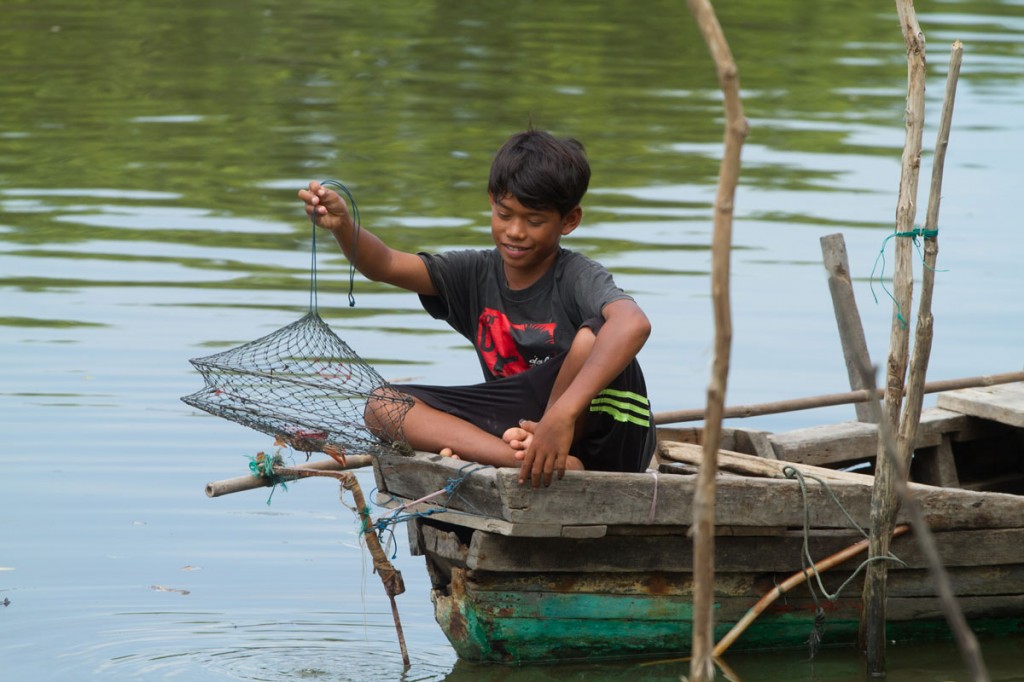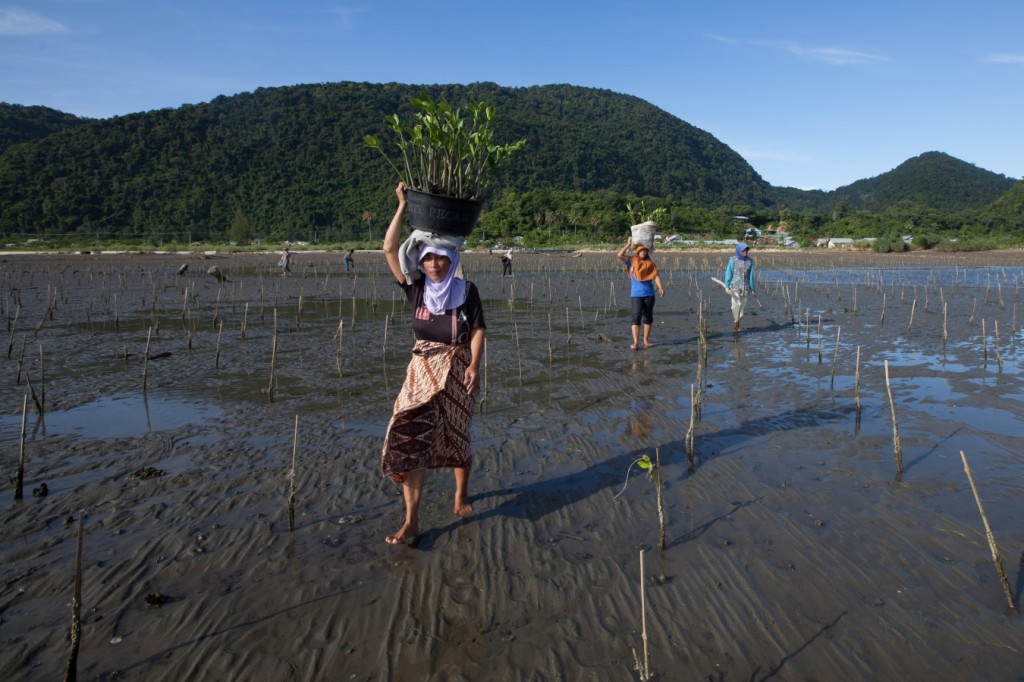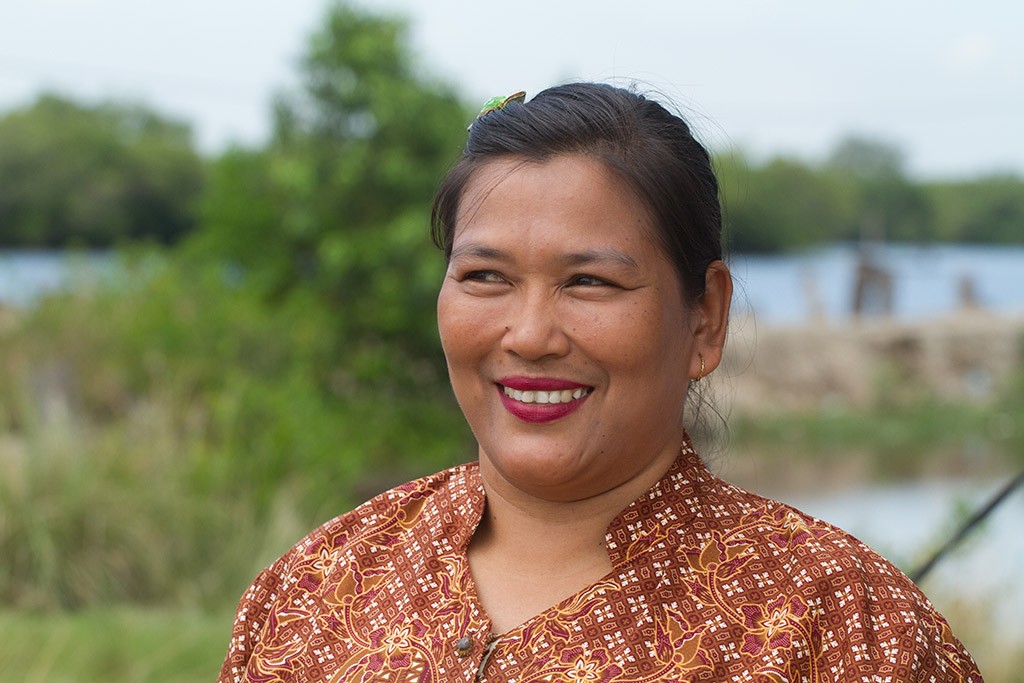With the support of the NGO Yagasu, coastal villagers in Sumatra mobilized to restore mangroves that protect their shores and serve as important sources of food and income for the local communities. A plantation of 18 million mangrove trees over 5,000 hectares was completed in the region of Medan and in Aceh, an area severely affected by the 2004 tsunami. 125 villages were involved with this project.
Rebuilding Fish Stocks
In these villages, the Livelihoods project demonstrates how restoring degraded wetlands can go hand-in-hand with fighting poverty and improving family income. By restoring the mangrove plantations, Yagasu has recreated a barrier for coastal protection and revived a bio-diverse habitat. It has also enabled the communities to revive their abandoned fish ponds- an approach that has improved food security.
The “silvofishery” approach combines mangrove planting with diversified aquaculture. This means that mangroves are planted around and in the fishponds, providing a natural fertile habitat that attracts various species of fish, shrimp and crabs. This species diversification leads to a more varied income for fishermen and more plentiful bounty. One of the highest income-generating activities in the community today is the sale of soft-shell crabs that are cultivated in these ponds, and then shipped for export.
These communal fishponds help increase the revenues and livelihoods of 14 families. Each farm produces an average of 10 tons of fish, 700 kilograms of shrimp and 1.8 tons of crabs per year.
A revolving microcredit fund set up by Yagasu provides fishermen with loans to create these fishponds, which require an average investment of 1200 euros to set up. As a consequence, the fishermen are encouraged to continually plant and nurture mangrove trees in the fishpond areas.
Making Batik from the Mangroves
In addition to silvofishery, the mangroves also produce other valuable by-products that can be sold on the market. Yagasu teaches the communities how to care for the newly-planted mangrove trees, but also how to valorize every component of the tree- from root to trunk to leaf- and to produce goods as varied as jams, cookies and even natural dyes.
These dyes are used to produce beautiful hand-painted traditional batik scarves that are sold commercially in Indonesia. “Right now, we already have 22 different natural colors,” said Bambang Suprayogi, the founder of Yagasu. “We are now advancing our techniques by experimenting with organic batik material made from hand-woven banana fibers.”
An interesting aspect of the Livelihoods Carbon Fund is that it offers its partner NGOs not only financing to carry out their projects, but a valuable platform that facilitates the exchange of information and resources between the public and private sector. For instance, each of the fund’s partner companies has the opportunity to go behind just financial contributions by providing technical and operational support to the NGOs. Hermès, the French fashion house famous for its iconic silk scarves, often provides Yagasu with tips on the best methods to process the dye created by the mangrove trees.
The batik scarves made by the villagers are now being sold in Jakarta’s main airport terminal and Yagasu is opening its own standalone boutique this month in East Java, which will sell products produced by the communities involved with the mangrove restoration project ranging from embroidered to hand painted fabrics.
Facilitating Access to Market
Suprayogi says the most vital yet challenging aspect of this project was helping villagers find appropriate markets for their products. “We always had an economic approach to our project because when someone does something they should receive tangible returns,” he said. “In order to encourage the communities not to cut down the mangrove trees, they needed to see that they could really benefit from them in an economic way.”
Sales from goods produced from the new mangrove plantations have increased the revenues of local villagers by 57 percent (up from the median household income of 175 euros a month to 285 euros a month), according to Suprayogi.
Yagasu currently supports 174 group cooperatives by giving them branding and marketing advice and helping them secure licensing permits from the local government to sell their products. The jams and cookies produced by the mangroves are not sold in Yagasu’s name, but rather in the name of the cooperative. This is an important point as it empowers the villagers and gives them pride in what they do.
Following the success of the Livelihoods mangrove replantation project, Yagasu is now being supported by the Indonesian government and USAID. A project that started over biodiversity concerns has now widened to spur the local economy and in the long term, Suprayogi’s dream is to support education and healthcare efforts in the region. “I feel happy if the villagers are smiling,” he said. “I can see a big difference in their lives.”




